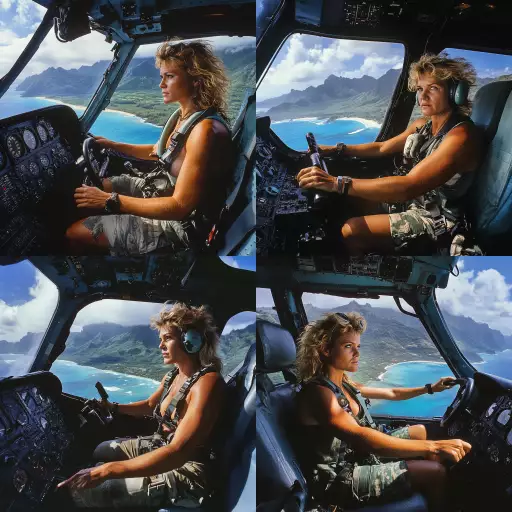Explore the Best AI Image Gallery

The Fusion of Flesh and Data: How Wearable Tech is Transforming the Creative Industry
For centuries, art has been an expression of the human experience—a tangible manifestation of emotions, ideas, and perceptions. Yet, in the 21st century, a new paradigm is emerging, one where the lines between the physical and digital realms are increasingly blurred. Wearable technology, with its ability to capture physiological data and translate it into creative outputs, is at the forefront of this revolution, ushering in an era of unprecedented artistic possibilities.
Imagine a world where your heartbeat rhythms inspire a symphony, your brainwaves paint vibrant abstract landscapes, or your every movement sculpts a dynamic digital sculpture. This is no longer science fiction; its the reality being shaped by wearable tech. Artists and designers are embracing these innovative tools to explore new dimensions of creativity, pushing the boundaries of whats considered art.
From Sensors to Sensations: The Tools of the Trade
The rise of wearable tech in the creative industry is fueled by a diverse range of devices. Smartwatches and fitness trackers, with their sophisticated sensors, can capture a wealth of physiological data—heart rate, skin conductivity, body temperature, and even brain activity through EEG headsets. This raw data, once confined to scientific analysis, is now being repurposed as the very essence of artistic creation.
Examples of Wearable Tech in Creative Expression:
- Interactive Installations:
- Bio-responsive Art:
- Generative Music and Sound Design:
- Virtual Reality (VR) and Augmented Reality (AR) Art Experiences:
Imagine stepping into an immersive installation where your heartbeat triggers light patterns or your movements influence the flow of a digital soundscape.
Artists are using biofeedback sensors to create sculptures and installations that respond in real-time to the emotions and physiological states of viewers. As you stand before a piece, your breathing might alter its colors, or your stress levels could trigger a pulsating rhythm.
Wearable sensors can translate movement into music, creating personalized soundtracks based on a dancer’s choreography or a musician’s performance.
By integrating wearable sensors with VR and AR headsets, artists are crafting immersive experiences that respond to the users presence and actions, blurring the line between reality and imagination.
The Ethical Landscape: Navigating New Frontiers
As with any transformative technology, wearable tech in the creative industry raises important ethical considerations:
- Data Privacy and Security:
- Bias and Representation:
- Accessibility and Equity:
Wearable devices collect a vast amount of personal data. It’s crucial to establish clear guidelines and safeguards to protect user privacy and ensure that data is used ethically.
AI algorithms trained on biased datasets can perpetuate existing inequalities in the creative field. Its essential to address these biases and ensure diverse representation in both the development of wearable tech and the art it generates.
The cost of wearable technology can create barriers for some artists and communities. Efforts should be made to make these tools accessible to a wider range of creators, fostering inclusivity in the creative process.
A Glimpse into the Future: Wearable Techs Creative Trajectory
The future of wearable tech in the creative industry is brimming with possibilities:
- Hyper-Personalization:
- Collaborative Creations:
- The Convergence of Art and Science:
Imagine art experiences that are uniquely tailored to your emotions, preferences, and even your physical body.
Wearable sensors could facilitate real-time collaboration between artists across geographical boundaries, allowing them to co-create works in a truly immersive and interconnected way.
The line between art and science will continue to blur as wearable tech allows us to explore the intersection of creativity, neuroscience, and data visualization.
Wearable technology is not just a tool; its a catalyst for a paradigm shift in how we create, experience, and understand art. As these technologies evolve, they will undoubtedly unlock new frontiers of artistic expression, empowering creators to push the boundaries of imagination and shape the future of creativity.




](https://images.ai-img.art/thumbnails/150/51c93500396faff4e7fa8b42bc68033067b16b2230e3496e95c482a581ff0fe9.webp)

![**Representation: A dog acting as a private tutor to a child. The dog holds a ruler in its paw and stands at the blackboard to explain a dog diagram to the child. Graphic style: Line drawing, cartoon style, influenced by Franco-Belgian comics, thick black lines, simplified design, vector, black and white only, in the style of Keith Haring or the French comic strip "Alinéa". [IMPORTANT]: A single continuous line extending from one side of the image to the other, minimalist, strong outlines, line drawing, without lifting the hand, ultra-simplified, no shading, entirely white image, drawing created in the center of a sheet of paper. --ar 16:5** - <@627984126871470085> (fast)](https://images.ai-img.art/thumbnails/150/7a854648a81e51241dcca8d24dd6e3bfcf07ad1df51baf401c9b729f4cf411fa.webp)
](https://images.ai-img.art/thumbnails/150/157712d76865d557120f9baf988de3d0525225295a2789c89bf2c4a5a96a03d1.webp)








![**Representation: A teenager smiling while thinking about a friendly dog, a comic-style thought bubble with a friendly dog inside. Graphic style: Line drawing, cartoon style, influenced by Franco-Belgian comics, thick black lines, simplified design, vector, black and white only, in the style of Keith Haring or the French comic strip "Alinéa". [IMPORTANT]: A single continuous line extending from one side of the image to the other, minimalist, strong outlines, line drawing, without lifting the hand, ultra-simplified, no shading, entirely white image, drawing created in the center of a sheet of paper. --ar 16:5** - <@627984126871470085> (fast)](https://images.ai-img.art/thumbnails/150/6fc850f638e3dee0c4b121acecad2c8419e02bdeac7f871d625f1003c1c3abe1.webp)
![**Representation: A dog acting as a private tutor to a child. The dog holds a ruler in its paw and stands at the blackboard to explain a dog diagram to the child. Graphic style: Line drawing, cartoon style, influenced by Franco-Belgian comics, thick black lines, simplified design, vector, black and white only, in the style of Keith Haring or the French comic strip "Alinéa". [IMPORTANT]: A single continuous line extending from one side of the image to the other, minimalist, strong outlines, line drawing, without lifting the hand, ultra-simplified, no shading, entirely white image, drawing created in the center of a sheet of paper. --ar 16:5** - Variations (Strong) by <@627984126871470085> (fast)](https://images.ai-img.art/thumbnails/150/f4e034998ccd869d8a061fd12017514fcd92210eb33d4222dc9b54716223f4dd.webp)






](https://images.ai-img.art/thumbnails/150/9d51c5e673b4f2068b7b01abc35425a06f173b76303adf9ad29ca14302c25b18.webp)



















